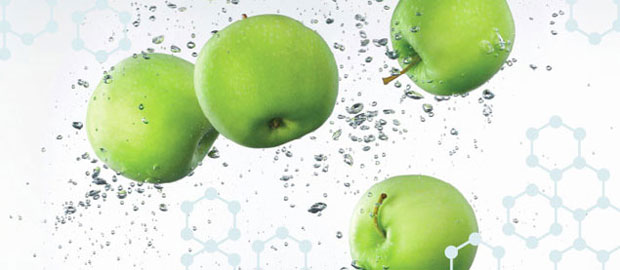 PETER DAZELEY / GETTY IMAGE
PETER DAZELEY / GETTY IMAGEThe innovation is still being tested and should have an impact on agroeconomics, because by conserving fresh food for longer it will help reduce the waste of fruit and vegetables, which according to statistics from the Ministry for Agriculture, reaches 35% of all Brazilian production. In Brazil the research is conducted by the Department of Biochemistry at the Federal University of Pernambuco (UFPE). In Portugal the Institute of Biotechnology and Bioengineering at the University of Minho (Uminho), in Braga, is in charge of the studies. The two groups started cooperating in 2005 on a project funded by the European Union, the Alfa-Valnatura, with participation from institutions in five other countries: Argentina, Cuba, Spain, Ireland and Mexico. Afterwards, the group of Brazilians and Portuguese continued the studies in other programs.
The edible nanofilms or nanocoatings are fine, colorless, and invisible to the naked eye and completely cover the food. They comprise various layers of polysaccharides, which are natural polymers that have been used for a long time by industry for making sauces, for example. To develop the nanofilm, various polysaccharides were tested. “We can highlight some polysaccharides that have good properties for selectively barring the passage of gases, such as quitosane, which is extracted from the shells of crustaceans, alginate, from brown seaweeds, k-carrageenan, from red seaweed, polycashew, from cashew tree gum and pectin, whose most important commercial source is the pulp of apples and the skin of citrus fruit,” says biochemist, Maria das Graças Carneiro da Cunha, from UFPE. Nanofilms made from these polysaccharides have no taste and because of this do not interfere with the taste of the food. “The calorie level is very low and the food can be eaten by diabetics,” says Maria das Graças.
 Low cost
Low cost
The researcher explains that there are three ways of applying these nanomaterials. The first is by immersing the food in polyelectrolytic solutions, formed by polysaccharides or proteins. As a result, they obtain the nano-laminated coating that in many cases is capable of changing the surface characteristics. This method, according to Maria das Graças, is considered low cost and versatile. It is a simple technique and needs no complex equipment. Another way of obtaining the nano-laminated coating is by sprinkling the same polyelectrolytic solutions onto the food. This is also a good option because it can be adapted to fit existing conditions in the food industry used for washing food. Finally, there is another application in which the food is wrapped in a film, as if it was covered by a transparent skin. In this case the film, although it is very fine is more voluminous, on a micrometric scale.
“I see no pros or cons in any of these methods. It’s going to depend on the type of food and the purpose for which it is intended,” says the researcher from UFPE. “From what I’ve seen in Brazil, the immersion method is pretty feasible, because tanks are used in which the fruit is immersed for the preservation treatment to take place. But the sprinkling method is also possible, because the fruit goes through a conventional washing process before the preservation treatment. Only after a general analysis, including costs, will it be possible to say which of the methods is the most suitable,” she says. This is also the opinion of Portuguese chemical engineer, José Teixeira, who coordinates the research at the University of Minho, alongside researcher António Vicente. “So far, tests in the laboratory have shown the same results as the conservation of products, but with different costs because of the use of film. It’s too early to say which of the methods will be the most feasible for use in industry,” says José Teixeira.
One additional advantage of nanofilms is the fact that they allow for the inclusion of bioactive compounds, like antimicrobials and antioxidants. “The film can become a vehicle for incorporating these compounds, allowing for food with better properties,” says the Portuguese researcher. “The microbial and antioxidant agents can be gradually released onto the surface of the food,” points out Maria das Graças. In Portugal, tests carried out on fine films on a nanometric scale gave encouraging results. The level of losses in strawberries fell by 30% and cheese by 20%, according to the team from Uminho. In Brazil, fishing engineer, Bartolomeu Souza, who finished his PhD in November 2010 at the Portuguese institution, has applied edible micrometric size films and coatings for prolonging the shelf-life of fish. “Our studies revealed that microbes grew more slowly on samples of salmon coated with the film, which allowed the sell-by date of chilled fish to be extended by up to three days,” says Bartolomeu. After returning from Portugal, he was accepted as a professor at the Federal University of Ceará (UFC).
Tests on different films developed by Brazilian and Portuguese scientists are making progress, but they still have not received authorization from the health authorities in the two countries for commercial use. Brazilian and foreign companies have already shown an interest in selling the technology, but according to Maria das Graças, “we’re still at the negotiating stage.”
Scientific article
MEDEIROS, B.G.S. Polysaccharide/protein nanomultilayer coatings: construction, characterization and evaluation of their effect on ‘rocha’ pear (Pyrus communis L.) Shelf-life. Food and Bioprocess Technology. Published online on January 20, 2011.